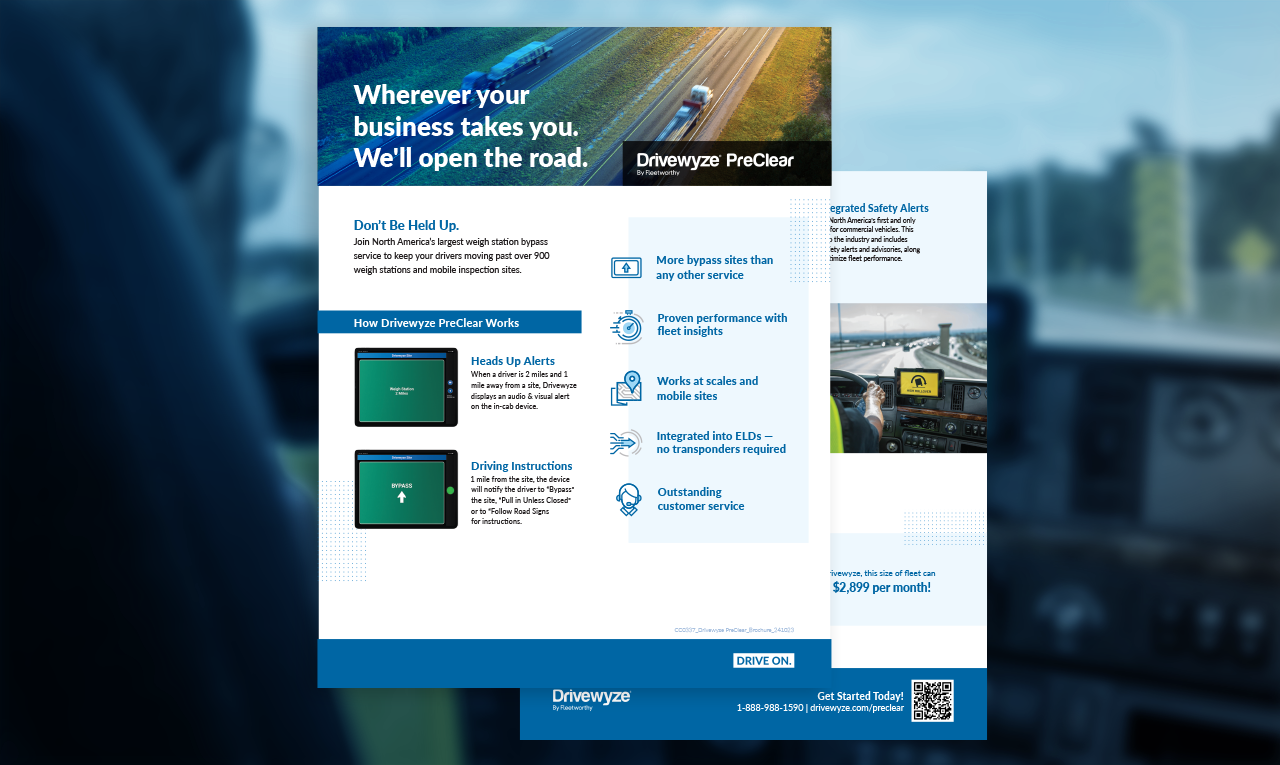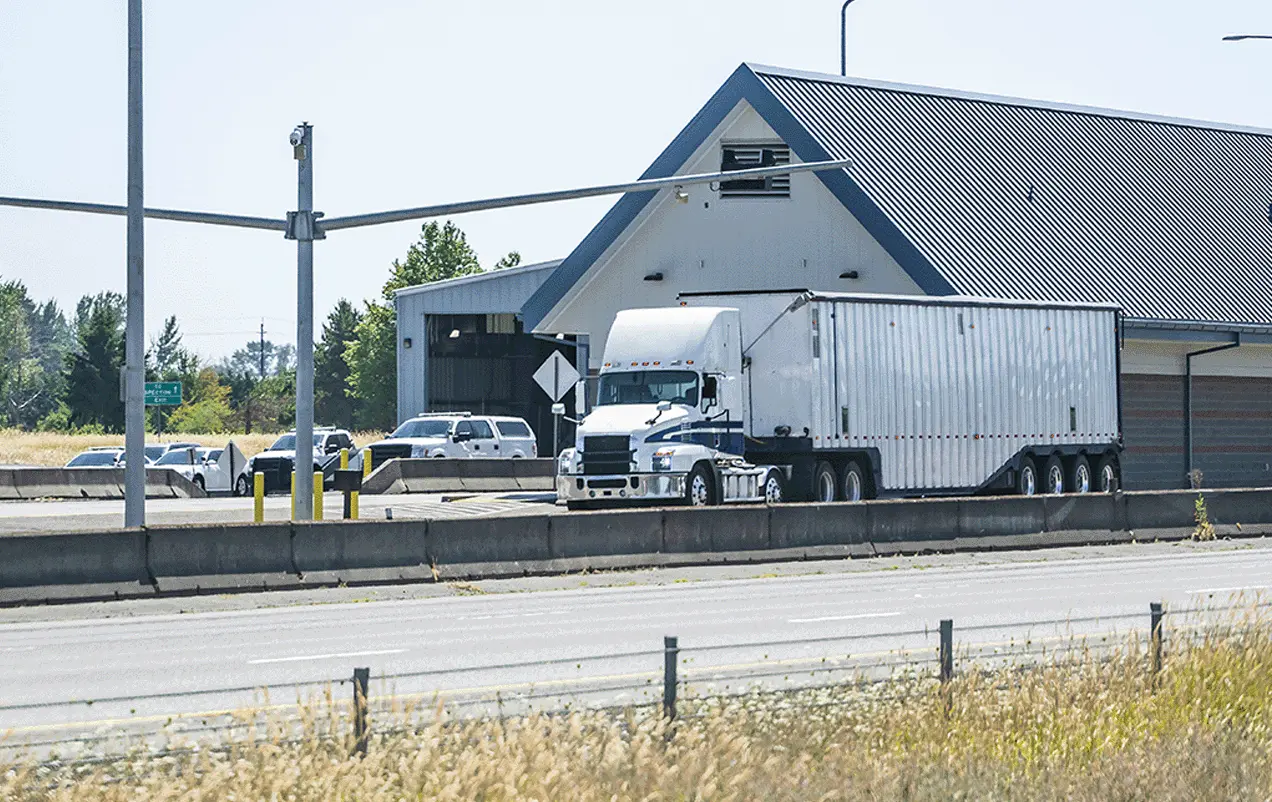Evaluating your fleet safety strategy and technologies?
Here’s why and how to build a program that keeps drivers safer and improves your bottom line.
Prioritizing safety is crucial for the success of any fleet, helping reduce costs, maintain industry reputation, and attract and retain drivers. However, there is a disconnect between fleet priorities and safety program investments. A 2023 report found that 95% of fleets prioritize safety, yet almost half say that they underinvest or drastically undervalue fleet safety initiatives and technology.
This is likely due to existing mindsets that treat fleet safety programs and technologies as cost burdens rather than ROI opportunities. In fact, the report also detailed that fleets typically rank increasing revenue and minimizing expenses above improving safety. Yet, safety investments are shown to offer fleets significant returns due to fewer incidents, lower insurance costs, and improved driver retention.
“The trend we’re seeing is that fleets that use safety technologies, such as Drivewyze Safety+, experience a significant return on their investment, helping improve safety scores and driver behaviors while reducing safety-related costs.”
Rob Abbott
Vice President of Customer Sucess, Drivewyze
Innovative fleets that do recognize these benefits and the advancements in fleet safety technologies are prompting safety processes and tools to evolve quickly in the industry. Understanding current safety best practices and tools can help you build a robust safety program and prioritize technologies that will have the biggest impact on fleet safety and your bottom line.
If you’re a fleet manager, owner, or operations director, this guide provides the basics for building an effective, forward-thinking safety program, covering:
If you’re a fleet manager, owner, or operations director, this guide provides the basics for building an effective, forward-thinking safety program, covering:
- How a comprehensive safety strategy benefits fleets.
- Strategies and investments for ensuring fleet-wide safety.
- Best practices for safe driving.
- Technologies to support safe driving.
Who is Drivewyze?
Drivewyze has 20+ years of experience in building hardware and software to improve fleet safety and keep highways safer. Drivewyze draws on its team’s extensive industry knowledge working with fleets of all sizes, owner-operators, safety solution providers, and state safety enforcement agencies. Drivewyze Safety+, a leading transportation safety solution, is the result of a successful collaboration with safety teams at large fleets.
Fleets can realize three core benefits by investing in truck safety: Improved driver safety and retention, strong safety scores, and cost savings.
3 Reasons Why Truck Driver Safety is Crucial
Fleets can realize three core benefits by investing in truck safety: Improved driver safety and retention, strong safety scores, and cost savings.
1. Improved Driver Safety and Retention
The National Highway Traffic Safety Administration (NHTSA) estimates that over 40,000 people die in motor vehicle traffic crashes each year, indicating a “national crisis of traffic deaths on our roadways.” These dangers affect truck driver safety, considering that most fatal or serious-injury truck crashes also involve one or more cars, and car drivers are at fault in the majority of fatal car-truck accidents.
Comprehensive written safety policies, good driver training, modern safety technologies, and routine vehicle maintenance all contribute to safer driving behaviors and fewer incidents. Beyond reducing driver injuries and loss, safety initiatives also heighten fleet reputation and improve job satisfaction. In turn, this helps attract and retain staff in a competitive industry known for its high turnover.
2. Strong Safety Scores
Fleets with effective safety programs maintain healthy Compliance, Safety, and Accountability (CSA) and Inspection Selection System (ISS) scores. By reaching safety score targets and remaining compliant with transportation regulations, fleets can help:
- Improve their industry reputation.
- Lower insurance premiums.
- Become eligible for weigh station bypass programs.
- Satisfy Department of Transportation (DOT) requirements, potentially reducing audits.
Learn more about road regulations and safety scores for fleets:
- A Breakdown of CSA Scores and Why They’re Important
- How to Avoid Violations During CVSA Brake Safety Week
- What Are Smog Checks?
- Getting the Green Light: How to Get Bypasses Regardless of Your Safety Scores
- Is Your Fleet Canadian ELD Compliant?
- Everything You Need to Know About Electronic Logging Devices (ELDs)
3. Cost Savings
Fleets are under increased pressure to save costs and improve operational efficiency. Fleet maintenance is becoming significantly more expensive due to inflation, resource shortages, and global supply chain disruptions.
Investing in safety initiatives and technology reduces incident rates and lowers insurance premiums — one of the biggest financial barriers in the trucking industry. A comprehensive safety strategy that uses advanced tools, such as AI-powered dashcams and driver telematics, can also help fleets address an industry spike in nuclear verdicts. Nuclear verdicts are generally considered to be those that exceed $10 million, though some verdicts can be much higher.
“We all know about the nuclear verdict. We all know about how not only a nuclear verdict but ones that are below that level that used to cost $20,000 now cost $100,000.
The cost of physical damage insurance has really been underpriced for a while. One total-out of a truck and a trailer — that’s probably more than what you paid for the insurance for the entire year. That automatically puts it upside down.”
Brian Runnels
Vice President of Safety, Reliance Partners
Sufficient ISS scores also enable fleets to take advantage of weigh station bypass solutions. This allows drivers to skip unnecessary weigh station checks, which cost $13.17* on average for a typical three- to five-minute visit.
A strong safety culture, as well as perks like weigh station bypass eligibility, help fleets better attract and retain drivers. This provides significant cost savings, considering fleets may spend anywhere from $6,000 to $12,000 or more to hire a driver. Fewer incidents and bypass eligibility translate to less downtime and more efficient drivers, leading to further cost savings.

Fleet-Wide Safety Strategies
In this section, learn how to:
- Create a Proactive (vs. Reactive) Strategy
- Invest in Truck Safety Technology
- Establish Weigh Station Bypass Eligibility
- Build a Safety Culture
- Measure Truck Safety Performance
For many fleets, standard driver safety training, and written policies are the only safety strategies implemented due to a lack of budgets and resources. Only less than 25 percent of fleets expand on their program and incorporate complementary solutions like safety benchmarking, company culture, and advanced safety technologies.
However, the foundation of any effective safety strategy must include:
- Written driver policies
- Driver safety training
- Vehicle maintenance schedules
- Safety culture initiatives
- Safety equipment and technology
With these basics in mind, here are some essential safety strategies to leverage from a fleet management point of view.
Create a Proactive (vs. Reactive) Strategy
Fleets are better positioned to keep drivers safe and reduce costs by shifting their safety initiatives from reactive to proactive. Reactionary safety initiatives typically:
- Lack effective communication tools to prepare drivers for road risks.
- Overlook fleet-wide safety culture.
- Underinvest in safety technologies.
- Have minimal data to support incident investigations, insurance claims, and proactive safety planning.
- Focus on negative reinforcement when it comes to driver training.
Proactive fleets prioritize visibility into driver behaviors, often through technologies such as dash cams and driver behavior telematics. This helps fleets understand where and why incidents occur and develop communication systems and strategies that keep drivers prepared and reduce future risks.
Invest in Truck Safety Technology
Leading fleets understand that safety technology investments are crucial to a proactive strategy that reduces incident rates and delivers ROI. Data is central to modern safety technologies, using information from dashcams, ELDs, and other sensors to understand how trucks are operated. From there, data analysis and visualization software help fleets unpack this data and find patterns — for example, locations prone to speeding or high-risk customer yards.
Safety management personnel can then use insights to make more informed safety decisions and reduce risks. For many fleets, this means using in-cab alerts and driver coaching systems, such as Drivewyze Safety+, to support drivers before an incident occurs.
Fleet safety technologies can also have responsive functions, minimizing damage and loss when a risk is already occurring. These tools include collision avoidance and mitigation systems that autonomously control vehicles, as well as fatigue monitoring and distracted driver systems.
7 Common Fleet Safety Technologies
- Dashcams
- Electronic logging devices (ELDs)
- Driver behaviour telematics systems
- Data analysis and visualization software
- In-cab alerting and coaching systems
- Fatigue monitoring and distracted driver systems
- Collision avoidance and mitigation systems
Establish Weigh Station Bypass Eligibility
Weigh station bypass eligibility is often associated with driver efficiency and cost savings due to reduced fuel consumption and downtime. However, a bypass program also has safety benefits, helping fleets:
- Avoid the safety risks associated with entering weigh stations, including merging, exiting, and navigating congestion.
- Reduce weigh station shutdowns due to congestion, which can jeopardize truck safety and put everyone on the road at risk.
- Prevent safety score penalties caused by illegal bypassing.
Fleets can maximize the safety benefits of weigh station bypassing by using a transponder-free service, which doesn’t require drivers to be in a specific lane to function.
“The drivers who run our out-of-state (intermodal) trucks love Drivewyze because it allows them to stay on the road making money. It’s easy for them to use because it’s loaded on their tablets, and it works in the background. They don’t have to do anything except turn on their tablets. Plus, there’s no transponder for us to keep track of.”Karol Smith, Safety Manager, BarOle Trucking
Build Safety Culture
Safety strategies are more effective when integrated into the fleet culture. Fleets can accomplish this by incentivizing safe driving, either by gamifying safety accomplishments or offering drivers reimbursement, certifications, time off, additional training, and priority routes in exchange for safe driving behavior. This facilitates positive reinforcement, improving driver attitudes toward fleet safety and training.
Safety culture is also built by creating safety policies and procedures across different departments — not just drivers. For example, fleets can develop safety policies for personnel operating in and around company facilities, whether or not they operate vehicles. Cybersecurity and digital safety strategies can be established for office and technology workers. HR departments can also work on finding new opportunities to reinforce safety culture, such as organizing safety events or gathering employee feedback.
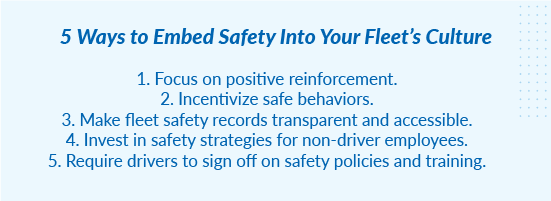
Measure Truck Safety Performance
Effective safety strategies continuously evolve, measuring performance over time and adapting accordingly. Every fleet has unique safety requirements, strengths, and weaknesses. Some common safety metrics to track include:
- Training completion rates
- Training and driver test scores
- Incident rates
- Incident types and severity
- Driver speed
- High-incident areas
Technologies such as driver behavior telematics are typically required to monitor and analyze this data both accurately and efficiently.
Key Metrics to Measure Truck Safety
- Training completion rates
- Training scores
- Incident rates
- Incident types
- Driver speed
- High-incident areas
Truck Driver Safety Tips for Written Policies and Training
Any fleet safety strategy starts with a written safety policy. As a minimum, all written safety policies should include guidelines around the following for drivers:
- Basic equipment
- Stopping distances
- Blind spots
- Turns and lane changes
- Seat belts
- Speed
- Pre- and post-trip vehicle inspections
- Customer yard protocols
- Hours of service, rest, and fatigue
Bonus Tip: In-Cab Alerts and Communication
Fleets that invest in modern in-cab alerting systems should also include policies and training around how to use and interpret notifications. Solutions like Drivewyze Safety+ support defensive driving and proactive safety, and help drivers prepare for:
- Road hazards
- Weigh station stops
- Speed risk zones
- High-citation areas
- Regional road laws
- Customer yards requiring special instructions
- Inclement weather
Essential Equipment and Solutions for Truck Safety
In this section, learn about available technology:
- Electronic Logging Devices (ELDs)
- Global Positioning Systems (GPS)
- Dash Cams
- Driver Behavior Telematics
- Collision Avoidance and Mitigation Systems
- In-Cab Alerting Systems
Electronic Logging Devices (ELDs)
ELDs are hardware devices installed in each truck that record hours of service data. This allows the Department of Transportation to manage drivers’ record of duty status (RODS) and ensure that drivers are sufficiently rested when operating vehicles. ELDs are now an essential part of modern fleet safety, with most long-haul fleets in North America legally required to install ELDs under federal mandates.
ELDs can also support driver behavior telematics, track fuel efficiency, and monitor engine diagnostics when integrated with an all-in-one fleet management system. This technology can help fleets identify unsafe driving behaviors and mechanical issues that may put drivers at risk.
ELD Mandates
–United States: Effective December 2019, all long-haul commercial motor vehicle operators in the US must install an ELD to maintain RODS.
–Canada: Effective January 1, 2023. Similar to the US mandate, Canadian regulations also require ELDs to be third-party certified.
Global Positioning Systems (GPS)
GPS systems enable fleets to locate trucks in real time. When combined with other operating data — such as driver speed, braking, and diagnostic issues — fleets can identify risk-prone areas and adopt safety strategies accordingly. For example, high speeding rates on a specific stretch of highway might prompt fleets to automate in-cab alerts or coaching as drivers approach the area.
Are your drivers using GPS jammers?
GPS jammers are small devices that intercept GPS signals and conceal a device’s location. While illegal, drivers can easily acquire these devices for a variety of reasons, from hiding off-duty locations to avoiding tolls.
GPS jammers are dangerous for fleets because they block communications and accurate vehicle data collection, which are required for safe driving. Fleets can use telematics solutions to detect GPS jammers and prevent them from interfering with fleet safety.
Dash Cams
Dash cams facilitate driver awareness and give fleets visual documentation of driving incidents. Fleet safety managers can also review footage to inform driver training and fleet safety strategies. There are a variety of dash cam technologies now available, including in-cab, backup, blindspot, night vision, and AI-powered dash cams, which can automatically detect unsafe driving behaviors.
Driver Behavior Telematics
Telematics technologies gather real-time data describing changes in how vehicles are being operated. This typically includes information such as vehicle speed, seatbelt usage, vehicle diagnostics, and braking behavior. When combined with other data — including weather and GPS — fleets can quickly identify risk patterns and develop more proactive safety strategies. Like dash cams, telematics technologies also provide a reliable record of vehicle behavior when investigating driving incidents.
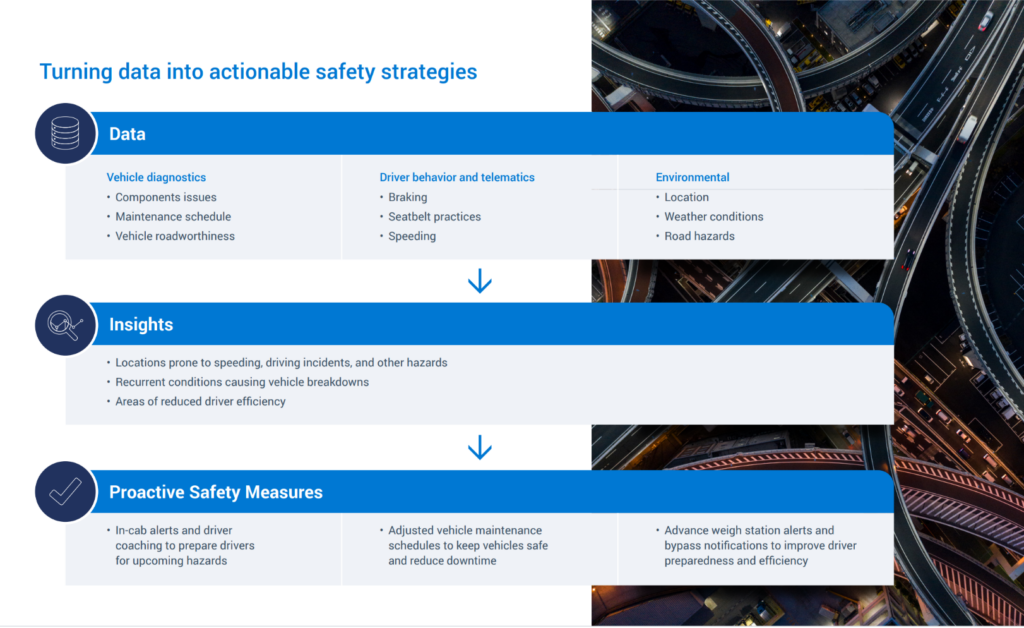
Collision Avoidance and Mitigation Systems
Collision avoidance and mitigation systems go one step further than data-gathering technologies, triggering autonomous vehicle controls when safety risks are identified. This helps drivers avoid incidents or reduce their severity. For example, emergency braking may be automated to avoid a collision if the system detects driver fatigue, risky stopping distances, or other red flags.
In-Cab Alerting Systems
In-cab alerting systems integrate various data types, such as GPS and driver telematics, to communicate with drivers in real time. For example, alerting systems can be set up to warn drivers about inclement weather, road hazards, safe parking spots, or special considerations at customer yards.
“I love my Drivewyze. It gives me enough time when approaching scales to prepare for entry or bypass, which saves time on the road. It also gives me the peace of mind knowing that it will alert me when unsafe areas are ahead so I can react early.”
Riverside Transportation Inc.
With in-cab alerting systems like Drivewyze Safety+, fleets can customize these systems to provide in-cab driver coaching or deliver instructions specific to your fleet. Unlike traditional alerting systems, which typically send blanket alerts regardless of driver location, Drivewyze Safety+ only notifies drivers when concerns are relevant to their location. This helps minimize alert fatigue, further improving driver awareness and safety.
Learn more about fleet safety tools from Drivewyze:
- Drivewyze Safety+
- Safety Notifications for Truck Drivers
- Drivewyze PreClear
- Driver Guide: Safety Notifications
- Comparing Weigh Station Bypass Solutions: Drivewyze PreClear and PrePass
- Weigh Station Bypass Coverage Map
Summary
Leading fleets understand that written policies and driver training alone aren’t enough to keep drivers safer and maintain lower operating costs. Safety strategies should also focus on building a safety culture and using innovations that improve fleet visibility and communications.
Investing in these strategies and technologies has a significant ROI, improving safe driving behaviors to reduce incidents, injury, property damage, and loss. These investments also have the added benefit of making drivers more efficient and supporting recruitment and retention. In the long term, fleets prioritizing safety culture and technologies can also lower insurance and incident costs, all while improving industry reputation and customer satisfaction.
Interested in learning more about proactive safety technologies from Drivewyze? Request a demo.
Are you a fleet owner-operator? Download the Drivewyze Android or iOS app.
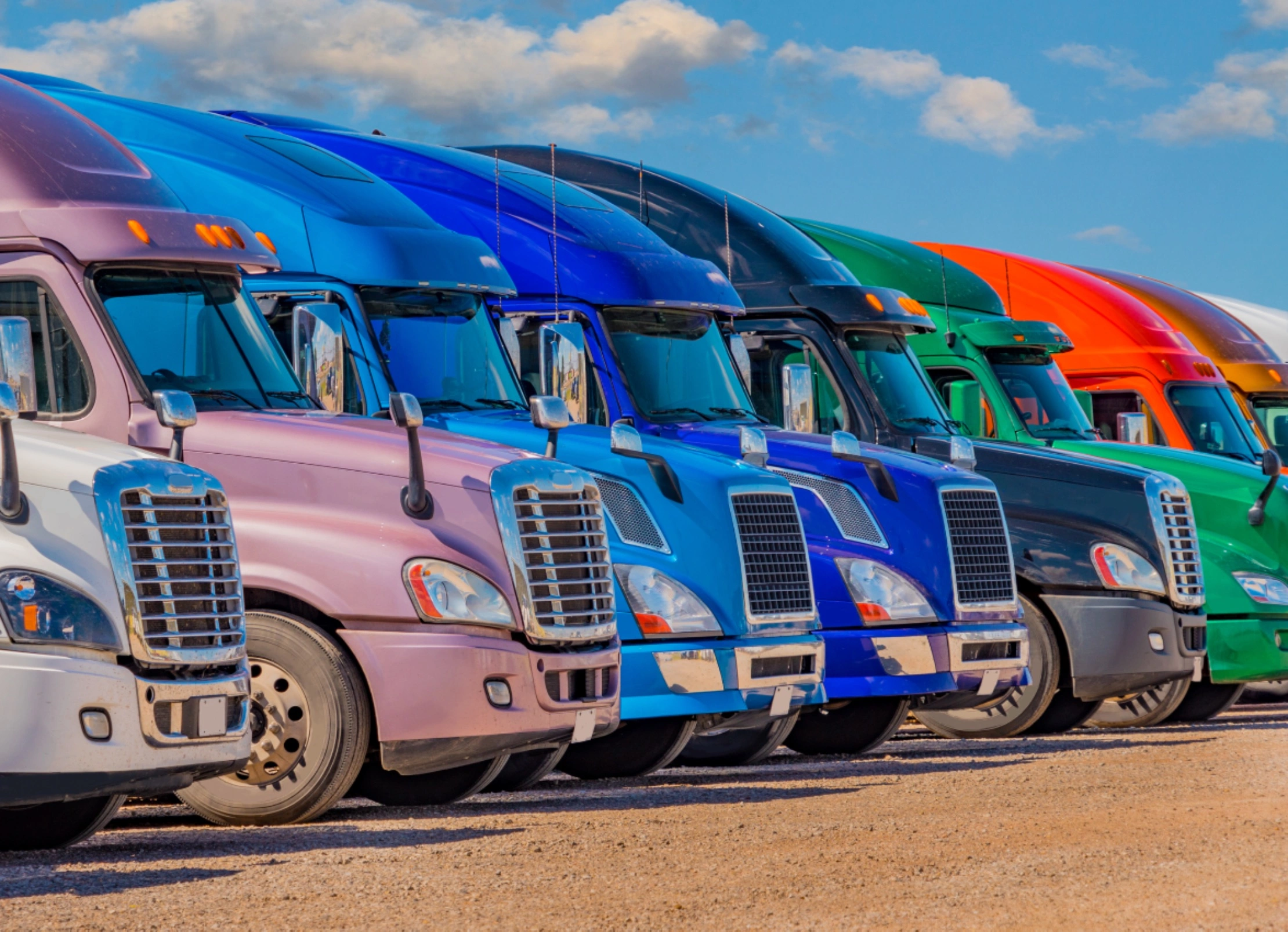
Ready to Get Started?
Learn how Drivewyze can improve commercial transportation safety and efficiency



